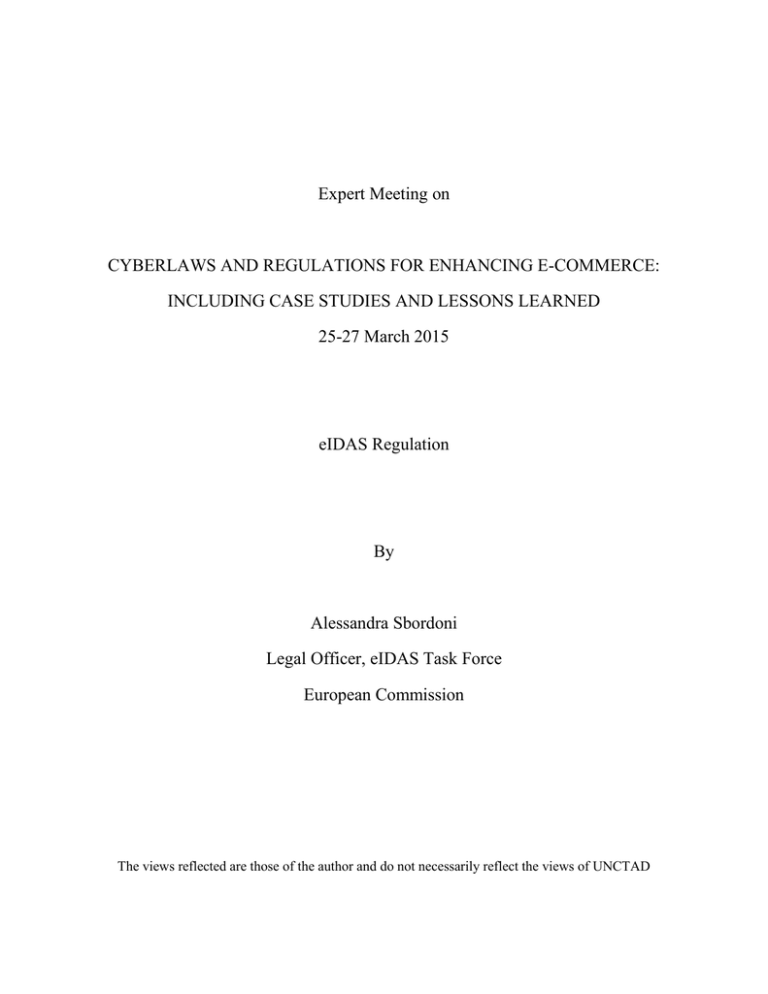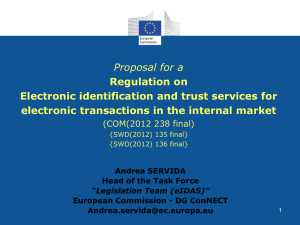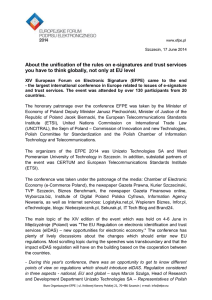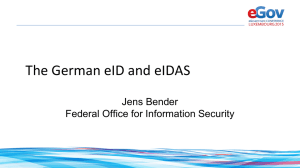Expert Meeting on CYBERLAWS AND REGULATIONS FOR ENHANCING E-COMMERCE:
advertisement

Expert Meeting on CYBERLAWS AND REGULATIONS FOR ENHANCING E-COMMERCE: INCLUDING CASE STUDIES AND LESSONS LEARNED 25-27 March 2015 eIDAS Regulation By Alessandra Sbordoni Legal Officer, eIDAS Task Force European Commission The views reflected are those of the author and do not necessarily reflect the views of UNCTAD eIDAS Regulation "Regulation (EU) N°910/2014 on electronic identification and trust services for electronic transactions in the internal market and repealing Directive 1999/93/EC" Expert meeting on Cyberlaws and Regulations for Enhancing E-commerce: including Cases Studies and Lessons Learned UNCTAD - Geneva 25 March 2015 Alessandra SBORDONI DG CONNECT, European Commission Legal officer eIDAS Task Force Alessandra.sbordoni@ec.europa.eu eIDAS breaks new ground • Provides legal certainty and fosters the usage of eID means for on line access ("world première") never regulated at EU level before • Addresses all the stages of a generic e-transaction, from the authentication of a web site to preservation • Provides the legal framework for a comprehensive “toolbox” of mechanisms and services to boost trust and confidence in electronic transactions 2 • eIDAS – Key legal aspects • • Art 114 TFEU on internal market as the legal basis Free movement of products and services • One single legislation for eID and trust services directly applicable in the 28 MS • Technological neutrality • Functional equivalence nondiscrimination “electronic = paper” • Transparency and accountability 3 The eIDAS Regulation 1. Mutual recognition of e-identification means 2. Electronic trust services: • • • • • Electronic signatures Electronic seals Time stamping Electronic registered delivery service Website authentication. 3. Electronic documents • 4 E-Transactions workflow Website authentication: check if the website you enter is really linked to the tax authority. E-registered delivery: Tax authority sends acknowledgement of receipt Preservation: storage of the tax declaration and acknowledgment of receipt eID: identify (or authenticate) yourself using, for instance, an eID means Time stamp: Proof of submission of the tax declaration in due time Submitting a tax declaration Creation of the tax declaration E-signature/ e-seal: Signing or Sealing the tax declaration 5 e-transaction's workflow – a concrete example: Submitting a tax declaration (1) 1. Website authentication => users (persons or companies) need to check if the website they enter is really linked to the tax authority. • 2. Electronic identification => users need to identify (or authenticate) themselves using, for instance, an eID means. 3. E-signature/e-seal => users may need to confirm the content and authenticity of the tax declaration, via an electronic signature (natural person)/ electronic seal (legal person). 6 e-transaction's workflow – a concrete example: Submitting a tax declaration (2) 4. e-delivery and time stamping => • The proof of timely submission of the tax declaration may be ensured via a time stamping. •• The tax authority may send a formal acknowledgment of receipt of the submission through a secure channel (electronic delivery system) which will also time stamp to confirm the time of receipt 5. Preservation => The tax declaration and the acknowledgment of receipt require to be stored and preserved to be presented to third parties in the future with the certainty that they will be legally valid. 7 7 eIDAS – Mutual recognition of eIDs Mandatory recognition of electronic identification Voluntary notification of eID schemes Assurance Levels: Cooperation and interoperability mechanism Liability high and substantial authentication Interop. FW free of charge for public sector bodies (and "low") 8 eIDAS – Trust services 9 eIDAS – Key principles The Regulation does not impose the use of eID and trust services • Key principles on eID - Mandatory cross-border recognition only to access public services – Full autonomy for private sector Principle of reciprocity relying on defined levels of assurance Interoperability framework Cooperation between Member States Key principles on trust services - Non-discrimination in Courts of electronic trust services vis-à-vis their paper equivalent Specific legal effects associated to qualified trust services Non-mandatory technical standards ensuring presumption of compliance Technological neutrality 10 eIDAS – Timeline of implementation 2014 2015 2016 2017 2018 2019 17.09.2014 - Entry into force of the Regulation 18.09.2015 - Voluntary recognition eIDs 1.07.2016 Date of application of rules for trust services: 18.09.2018 Mandatory 11 recognition of eIDs 11 eIDAS - What is the ambition? • Strengthen EU Single Market by boosting TRUST and CONVENIENCE in secure and seamless cross-border electronic transactions 12 Why a EU e-transaction legislation? • Address the challenges at national level to develop an EU interoperable e-transaction legislation • Cross border dimension of eIDAS 13 Why eIDAS targets cross-border dimension? • Insufficient scope (only covered e-signatures) and imperfect harmonisation of the e-signatures Directive 1999/93/EC • outdated standards and unclear supervision obligations • cross-border interoperability problems, and distortions in the internal market. • Fragmentation of the market: different rules apply to service providers depending on which Member States they serve. 14 Why eIDAS targets cross-border dimension? Challenges at national level Electronic identification schemes and means were deployed and developed in Member States' public sector environment New trust services emerged in national markets (e-seals, time stamps, e-registered delivery) or international environment (website authentication) 15 Why eIDAS targets cross-border dimension? Lack of cross-border technical interoperability Lack of common legal understanding National market silos no cross-border recognition of eIDs and difficulties in provisioning pan-European trust services 16 International dimension Development of a sustainable international cooperation best practice to foster cross-border e-commerce Legal interoperability compatible frameworks (cybercrime, data protection etc.) International standardisation removal of technical barriers 17 For further information and feedback Web page on eIDAS http://ec.europa.eu/digital-agenda/en/trust-services-and-eid Impact assessment http://eur-lex.europa.eu/legal-content/EN/TXT/?uri=CELEX:52012SC0135 Text of eIDAS Regulation in all languages http://europa.eu/!ux73KG eIDAS functional mailbox CNECT-TF-eIDAS-LT@ec.europa.eu EU_eIDAS 18






